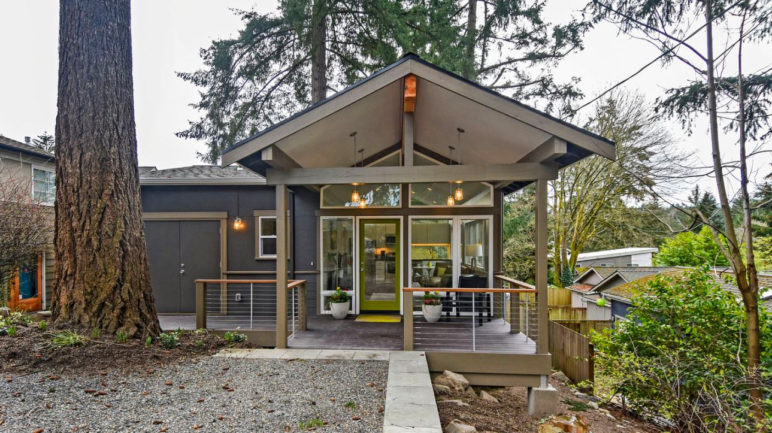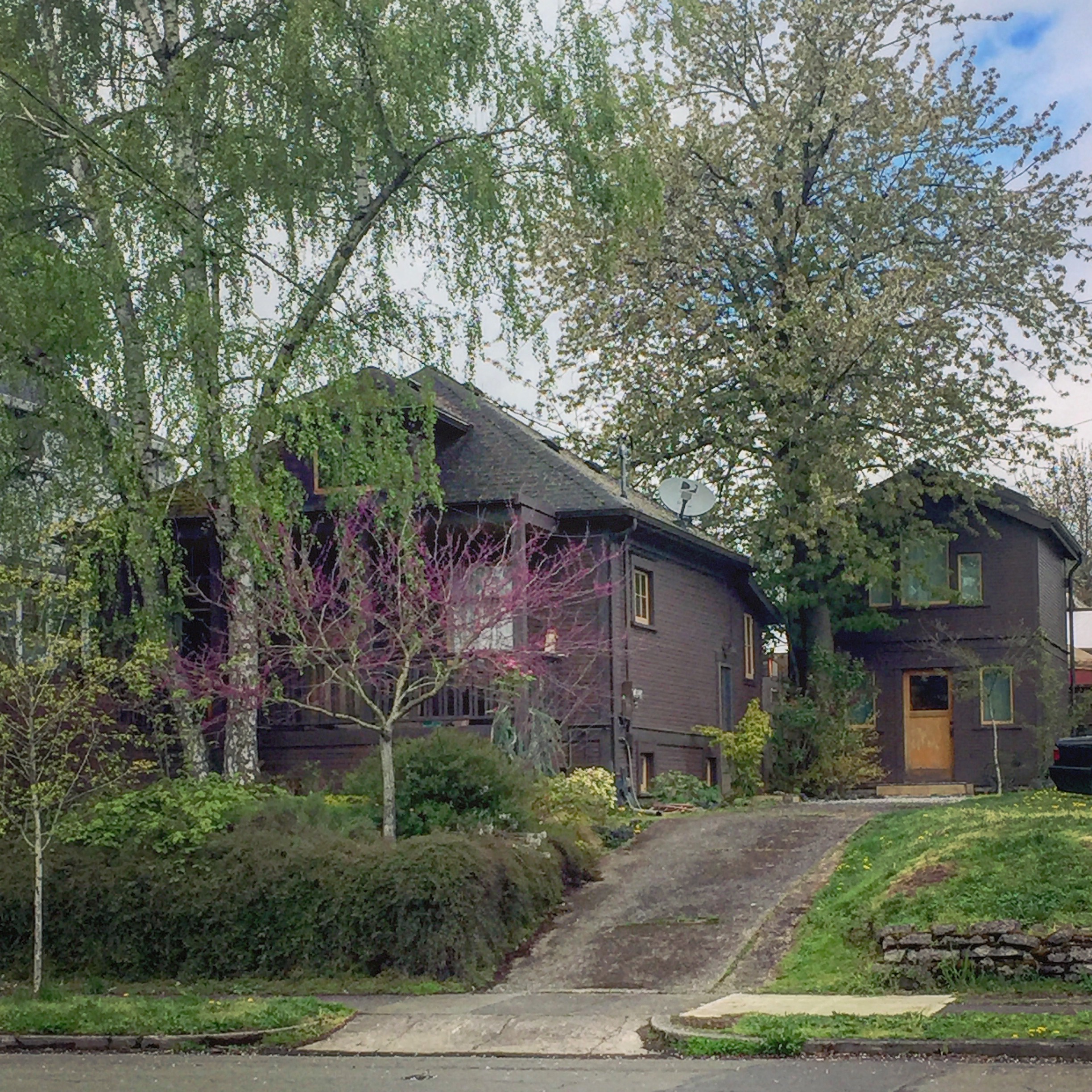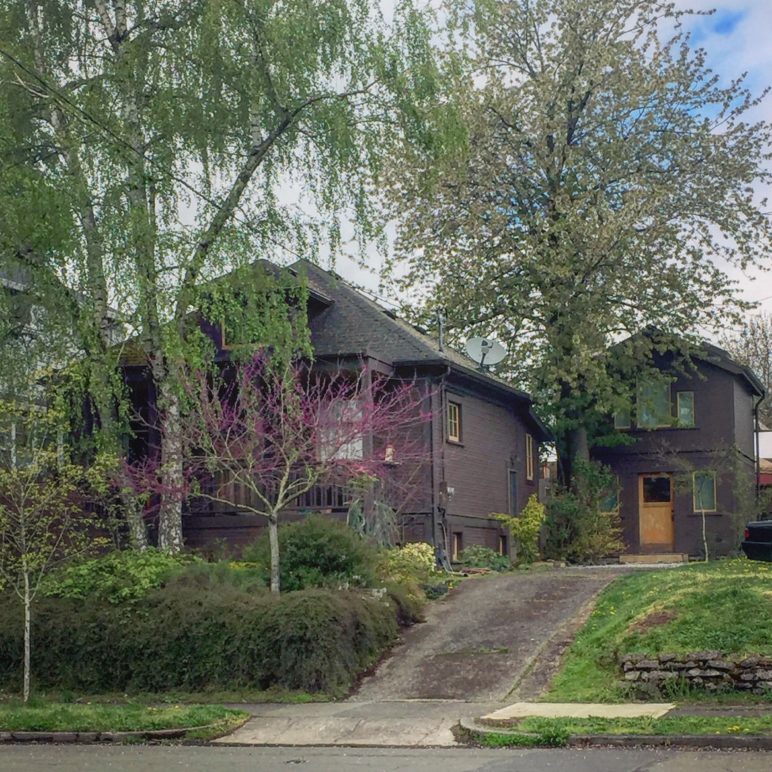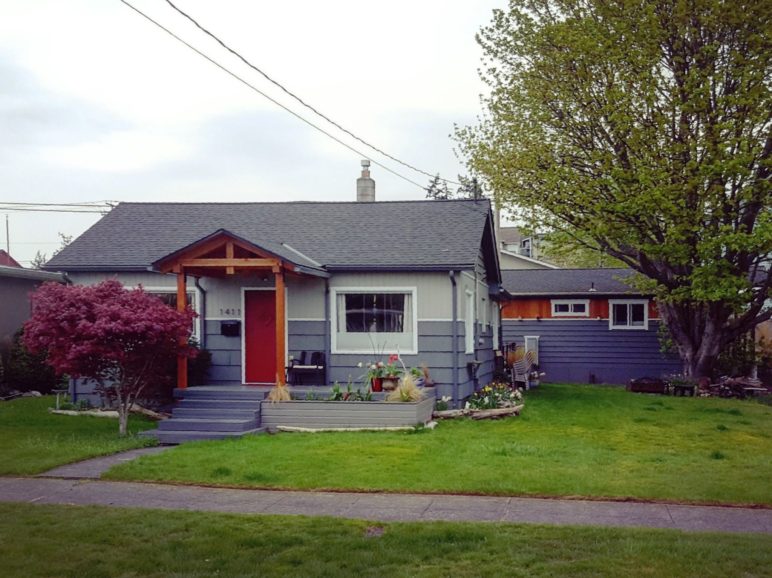Seattle City Council took a big step Monday toward creating a more sustainable city, voting unanimously to enact legislation that will make it easier for homeowners to build in-law suites, garage apartments, and backyard cottages—modest homes the wonks call accessory dwelling units (ADUs).
The vote caps an epic process during which obstructionists abused state environmental laws to drag things out for four years, as pro-housing affordability forces built up steam and finally won out over the objections of a tiny minority of anti-housing activists.
The adopted changes amount to the most progressive ADU policy in the US. By boosting the addition of ADU homes in the three-quarters of Seattle’s residential land reserved for expensive, single-detached houses, the new rules will lower the invisible walls of economic exclusion, and make the city greener too.
Two ingredients set Seattle’s policy apart: an allowance for not just one but two ADUs per lot, and a size limit on new houses. The only other major North American city permits two ADUs in single-dwelling zones is Vancouver, BC.* This flexibility maximizes opportunities for smaller, less expensive homes in neighborhoods otherwise filled with big, stand-alone houses.
Last year Minneapolis made national headlines with its plan to triplex the city. Depending on how Minneapolis implements that plan, Seattle’s new allowance could yield just as big an advance for welcoming moderate-income families to desirable communities.
The legislation’s house size limit of 2,500 square feet on a typical lot will make it more attractive to add ADUs to existing houses instead of tearing those houses down. And when teardowns inevitably occur—as they already do under the status quo—the size cap will provide a new incentive to build ADUs along with the new house. Neighborhoods will see fewer teardowns replaced by McMansions and more modest, mixed-income options.
Seattle also got rid of the two biggest ADU barriers: parking quotas and the requirement for property owners to live on site. For cottages, the legislation bumps up allowed size, height, and backyard coverage, making it easier to build family-friendly homes and lowers the minimum lot size to 3,200 square feet. And to avoid discriminating against non-traditional family arrangements, it raises the limit on unrelated occupants per lot from eight to twelve.
The council rejected an amendment that would have hindered ADU production by requiring a year of property ownership before granting permits. In a previous press conference, Councilmember Mike O’Brien took issue with the unspoken sentiment embedded in such rules: “This idea that somehow, you know, homeowners are better citizens on our streets than renters are, is just something I disagree with.”
Council also refrained from enacting a proposed outright ban on using ADUs for short-term rentals. Seattle already caps all short-term rentals at two per owner. Fully banning short term rentals in ADUs would quash flexibility and dissuade homeowners from building them.
Add it all up, and Seattle’s ADU policy is as good as it gets—Vancouver, BC, is the only other large North American city with a comparably liberal set of rules. Cities throughout Cascadia and beyond now have a living example of a way to craft policy that embraces ADUs and maximizes their benefits to both people and the planet.

Backyard cottage in Seattle’s Matthews Beach neighborhood. Photo by CAST Architecture, used with permission.
Anti-housing obstructionists turned common-sense ADU reform into a marathon
Sightline has long supported ADU reform, starting with research in 2013 that called out regulatory barriers. Sightline’s executive director served on Seattle’s Housing Affordability and Livability Agenda committee and helped ensure that the 2015 report included the needed changes to Seattle’s rules—recommendations (see page 25) that match the key fixes in the ordinance the city just adopted.
Councilmember Mike O’Brien proposed ADU legislation in late 2015 (here’s a timeline). Progress was stalled for a total of three years by two legal appeals filed by the Community Council of Queen Anne, a leafy Seattle neighborhood where the median home price is just shy of $1 million.
The delay did have one upside, though: it gave policymakers time to improve the original proposal by axing all ownership requirements, adding the option for two ADUs attached to the main house, and introducing a brand new approach: a size limit on new houses to tip the redevelopment scales away from McMansions and toward more ADUs. It also gave planners the opportunity to conduct extensive analysis that debunks specious claims commonly made by ADU detractors.
In May, nearly four years after city officials first called for ADU reform, the last appeal was dismissed, clearing the way for today’s unanimous vote led by Councilmember O’Brien. Over those four years, Sightline published a plethora of supporting research (scroll to the bottom of the article for a reading list).
Seattle wins with greener, more affordable housing choices
The new rules will yield more of the very type of homes Seattle desperately needs as it stares down both a climate and an affordability crisis. Nearly half of the city’s dwellings are stand-alone houses on large lots that are not only pricey, but also energy guzzlers. Low-density neighborhoods filled with block after block of big houses are a set up for heavy car reliance.
Because ADUs are compact, on average they use 40 percent less energy than a typically-sized, single-detached house. Over a home’s lifespan, that’s equivalent to taking nearly 100 cars off the road for a year. Tucking ADUs into existing neighborhoods also supports more walkable, transit-friendly communities, cutting climate pollution.
In addition to being economical because they are small, ADUs also tend to rent below market-rate, and 1 in 10 provides free housing to family or friends of the homeowner. Seattle’s reform is well-timed for the city’s growing population of seniors, many of whom hope to age in place. ADUs offer a practical option for adding age-friendly housing to established neighborhoods to help seniors stay in the communities they love.
How Seattle could polish up its already exemplary ADU policy
Notwithstanding Seattle’s stellar achievement on ADU reform, as think-tankers we’d be remiss not to suggest a few small ways in which policymakers could make it even better:
- Remove the requirement that the second ADU must either meet a green building standard, or be reserved for income-eligible households: These extra mandates will make it more financially challenging to construct ADUs—counterproductive policy for a housing type that is relatively green and affordable to begin with.
- Reduce or eliminate permitting and utility connection fees: These added costs can be deal breakers for homeowners on tight budgets (the most onerous fee on ADUs in Seattle is King County’s sewer connection charge).
- Allow the option of two backyard cottages, attached to each other, or detached: The same size limits that apply to a single cottage would apply to two cumulatively, so the built structure couldn’t be any bigger.
- Allow ADUs inside the main house to exceed 1,000 square feet: Exempt the first 1,000 square feet of ADU from the total house size limit, but allow the owner to divide the area inside the house however they like. Vancouver, BC, caps attached ADU size at no larger than the main house.
- Eliminate the minimum lot size requirement: Lot coverage limits and setback requirements preclude cottages on most smaller lots anyway, but some small lots—ones with very small houses, for example—could easily accommodate a backyard cottage.
- Remove occupancy limits based on legal relationship status: Over recent decades family structures have evolved and tend to be less conventional. Barring additional residents because they are not legally related is discriminatory.
The wave is swelling to end exclusionary zoning
Today’s progressive move to relax restrictions on ADUs is a big first step in a necessary evolution toward opening up Seattle’s expansive low-density residential areas to less expensive homes, and more of them. Momentum is spreading: earlier this year, Washington state legislators proposed a bill (destined to fail) that would have mandated rules similar to Seattle’s in larger cities statewide. California’s legislature is currently considering a bill that would enable cities to permit more than one ADU per lot.
To build on its success with ADU policy, Seattle can next take on re-legalizing middle housing—triplexes, townhouses, and small apartment buildings—in all residential zones. In a stunning display of how the debate has been shifting, just yesterday Oregon legislators voted to legalize duplexes almost everywhere in the state, and fourplexes in all larger cities. Seattle’s sister cities Portland and Vancouver, BC, both have middle housing plans in the works.
The Seattle Planning Commission has already laid out a path, writing that, “restoring the flexibility in housing types seen in Seattle’s historic residential neighborhoods is critical if the city is to achieve its goals of being a diverse, equitable and sustainable place to live.”
*Note: Smaller cities that allow two ADUs per lot in single-family zones: Tigard, OR (pop. 50,000), Troutdale, OR (pop. 17,000), Fayetteville, AR (pop. 87,000), Langley, WA (pop. 1,000) , and Richmond, BC (pop. 198,000), and Sonoma County, CA (largest city Santa Rosa, pop. 175,000). Toronto allows more than one ADU per lot in its multifamily zones, but only one attached ADU per lot in its single-family zones.
Thank you to Sightline Research Associate Nisma Gabobe for meticulous data mining to support this article.
Dan Bertolet, senior researcher, writes and speaks about housing and urbanism. He spent ten years in urban planning, working with both private and public sector clients on projects that promote sustainable community development. Dan has a (healthy) obsession with the complex interplay between housing affordability, land use regulation, and transportation, and he has published extensively on these topics.
Margaret Morales, researcher, is a policy analyst. She earned her Master’s from The University of British Columbia’s Institute for Resources, Environment, and Sustainability where she was a Bridge Fellow focusing on issues of public health and the environment. She received her Bachelor’s degree from Duke University in Environmental Science and Policy, and English. She also holds a certificate in Documentary Video from Duke and worked on films for non-profits in the United States, Canada, and Latin America.
If you have questions or would like to make a media inquiry with Dan or Margaret, contact Sightline Communications Associate, Kelsey Hamlin.












BK
Thanks so much for all your amazing work on this, Sightline peeps!
John Thacker
“The adopted changes amount to the most progressive ADU policy in the US… The only other major North American city permits two ADUs on a single-dwelling property is Vancouver, BC. ”
Well, except for Houston. (There are some neighborhoods with deed restrictions that the courts will enforce, but in general ADUs are by right and if one story don’t get into setback issues.) There are definitely homes in Houston with 2 ADUs (known locally as “garage apartments”) per lot.
Dan Bertolet
Thanks for pointing that out, John. The response we got from the Houston planning department seemed to indicate that only one is allowed:
“Our ordinance allows a second residential unit to be permitted on a single family residential lot with some conditions, such as a third parking space on site, and the second unit must be under 800 sf.”
Can you point us to any city documents that explain under what circumstances two additional residential units are permitted?
Dan Bertolet
The Houston planning department again confirmed with us that only one additional ADU dwelling is legal on single family lots:
John, perhaps the lots you’ve seen with two ADUs aren’t legal?
Curtis LaPierre
Thanks so much Dan and Margaret for tracking this so well over the years. Sightline has been the only news source to present the ADU issue accurately and in-depth. Keep up the great work!
Sean Galbraith
In parts of Toronto, you can have 2 ADU (one laneway suite and one secondary suite in the main building) on a property. In those same parts of the city, zoning permits everything from a single detached, up to a 4-storey walk up apartment. Possibly the single most diverse built form zoning permissions in Canada, or North America. Sadly, still no permission for a carriage house outside of a laneway condition.
@plannersean on twitter
Dan Bertolet
Thanks Sean. We found the code that permits two secondary suites here:
https://www.toronto.ca/legdocs/bylaws/2019/law0549.pdf#page=2
Can you point us to the code section that permits a laneway house and a secondary suite together?
Dan Bertolet
To summarize my offline email exchange with Sean, Toronto allows more than one ADU per lot in “R” zones, which are multifamily zones. In “RD” zones—the single-family zones that comprise 62% of residential land—the city allows one attached ADU (secondary suite) but not a detached ADU (laneway house). The city is currently considering extending the allowance for laneway houses to RD zones. But as it stands now, Seattle and Vancouver have more progressive ADU policy on a citywide basis because both allow two ADUs in all single-family zones.
John Thacker
“Possibly the single most diverse built form zoning permissions in Canada, or North America. ”
Except, again, for Houston.
Morgan
This is good news, although I hope we (the housing advocacy community) learned how to better get in front of opposition before proposing specifics.
Also, my experience is still that the biggest remaining obstacle is labor supply. It’s nearly impossible to hire additional people who are remotely qualified.
Dan Bertolet
Good point, Morgan. I think the only way to bring back labor supply is to offer more opportunity to build housing. Supply of labor will lag the demand at first, but we’ve got a lot of home building to do.
Paul Schissler
So far not so progressive? Offsetting some of the positives, the Seattle ADU upzone goes in the wrong direction when it incentivizes absentee ownership. Seattle could have incentivized resident ownership and co-ownership. It’s not clear cut, in my humble opinion, that “policymakers…improve(d) the original proposal by axing all ownership requirements.” I don’t live in Seattle, and I missed the debates about privileging the nonresident investors. We’ll see how it plays out, but now that the community has granted the rights to absentee ownership, we can predict resident ownership rates will be going down. Decommodification suggests that urban land and homes don’t always have to be seen as investments looking for a big return. Instead, what if we envisioned half of all homes being permanently affordable and matching the wide range of incomes in the jobshed? We’d have a much better chance at Fixing The Housing Mismatch if we aimed to fix it by using ideas like community land trusts, home co-ops, shared equity co-ownership, and permanent affordability. I wonder when Seattle will next have a chance to incentivize decommodification. And what other ways can we find so that workers who cannot afford what the market will bear will have nearby, affordable choices among the other half of all homes? I ask that we try to make permanent affordability one of the key ingredients.
Paul Schissler, community development planner
Dan Bertolet
Paul –
I totally agree with you that land trusts and co-ops are a great option. The problem is there’s no clear path for policy that municipalities can use to boost them to the needed scale. What do you suggest?
On the question of “non-resident investors,” this recent article indicates it’s not an issue in Seattle. Do you have any contrary evidence you could share?
https://crosscut.com/2019/07/will-wall-street-invade-seattles-single-family-neighborhoods-not-likely-experts-say
Paul Schissler
Thanks, Dan. Let’s talk soon. What would we suggest for a path that municipalities can use to boost community land trusts and home co-ops as an option? If we want permanent affordability, the path is wide open in WA: public funding for staff time, outside contractors, expertise, and creativity as long as the focus is on the “poor and infirm” (WA Constitution Article VIII Section 7). I’m not an attorney, so double-check whether it’s correct to say poor and infirm is defined, in housing programs, as people with incomes at or below 80 percent of area median income. Muni’s can be proactive, catalyzing permanently affordable projects with their own staff and/or by outsourcing aid to projects that aim to be permanently affordable.
Where I said non-resident investors, I meant absentee owners who do not live on the property, whether they live two blocks away or invest in Wall Street REIT. I’m not passing judgment; I’m just saying it’s better if half of all homes don’t have to be a commodity for investors looking for income, capital gains, or a windfall. Instead of granting and gifting the permission to build/upzone to the privileged investors/absentee owners of residential property, Seattle could have allowed the upzone only if it resulted in owner-occupancy, co-ops, CLTs, and other forms of co-ownership and permanent affordability.